Latest News
Anant Ambani’s Courtesy Visit to UP CM Yogi Adityanath: A Gesture of Diplomacy and Community Engagement

Contents
Introduction
In a notable event, Anant Ambani, the son of prominent business magnate Mukesh Ambani, recently paid a courtesy visit to Uttar Pradesh Chief Minister Yogi Adityanath. This meeting marks a significant intersection of business leadership and political authority, shedding light on the potential for collaboration between the private sector and government initiatives. Anant Ambani, representing a conglomerate recognized for its influential presence in various sectors, underscores the critical role that large businesses play in shaping socio-economic landscapes. His visit to Adityanath, a key figure in Indian politics, particularly in the context of Uttar Pradesh, highlights a strategic engagement meant to foster relations between the Anant Ambani family and state administration.
This visit stands as a testament to the growing trend of personal diplomacy where business leaders engage with political figures to discuss matters that transcend traditional business. In a state like Uttar Pradesh, which is known for its diverse population and economic potential, such interactions are crucial for community development and sustainable business practices. The engagement between Anant Ambani and Yogi Adityanath encapsulates various elements including investment opportunities, infrastructural development, and corporate social responsibility initiatives. It invites discourse around how such high-profile meetings can influence community relations and reflect broader socio-political dynamics.
As Uttar Pradesh continues to evolve within India’s economic framework, the involvement of influential business figures like Anant Ambani could signal important shifts in policy and investment directions. The implications of this visit may resonate beyond immediate business interests, potentially laying groundwork for collaborative efforts aimed at enhancing the welfare of communities throughout the state. Such engagements emphasize the necessity for synergy between corporate and governmental entities in navigating the complexities of modern governance and economic progress.
Anant Ambani: A Brief Profile
Anant Ambani, the youngest son of Mukesh Ambani, is a prominent figure within the Reliance Group, one of India’s largest conglomerates. Born on April 10, 1995, Anant has embarked on a journey marked by significant educational and professional milestones. He pursued his Bachelor’s degree in Finance from Brown University in the United States, which has equipped him with a solid foundation in business acumen and strategic decision-making.
Anant Ambani ole within the family business has been steadily evolving. The Reliance Group, founded by his grandfather Dhirubhai Ambani, comprises various sectors, including petrochemicals, telecommunications, retail, and energy. As a key member of the executive team, Anant Ambani has been entrusted with responsibilities that align with the company’s strategic vision. Anant Ambani involvement in projects such as the expansion of Reliance Jio, the telecommunications arm of the group, reflects Anant Ambani contribution to the company’s innovative edge in the fast-paced digital landscape of India.
Beyond his corporate responsibilities, Anant Ambani is becoming increasingly recognized for his efforts in social engagement and philanthropy.Anant Ambani is actively engaged in various charitable endeavors through the Reliance Foundation, which focuses on education, health, and rural development. This dual role as a businessman and philanthropist allows Anant to make impactful contributions to society while strengthening the Reliance Group’s commitment to corporate social responsibility.
In recent years, Anant has gained prominence in both business and social circles, often representing the Reliance Group at various forums and networking events. His interactions with influential leaders and stakeholders showcase his role as a young leader poised to make significant contributions to India’s economic landscape. Anant Ambani’s blend of education, corporate involvement, and philanthropic spirit positions him as a crucial player in shaping the future of the Reliance Group and its impact on society.
Yogi Adityanath: A Political Overview
Yogi Adityanath has emerged as a prominent figure in Indian politics, particularly in the context of Uttar Pradesh, one of the country’s most populous and economically significant states. Born in 1972, he assumed office as the Chief Minister of Uttar Pradesh in March 2017, representing the Bharatiya Janata Party (BJP). His political career, however, began much earlier, as he was elected as a Member of Parliament for the Gorakhpur constituency in 1998, marking the start of his long-standing association with governance and public service.
Adityanath’s governance style is characterized by a blend of religious sentiment and developmental agenda. He is known for his assertive approach towards law and order, emphasizing the need for safety and security in a diverse state like Uttar Pradesh. Under his leadership, the government has introduced several key policies aimed at enhancing infrastructure, improving healthcare, and promoting education. Initiatives such as the ‘Mission Empowerment,’ aimed at creating job opportunities for the youth, reflect his inclination towards pragmatic governance.
Uttar Pradesh plays a crucial role in the Indian economy, contributing significantly to the nation’s agricultural output and industrial production. Its strategic location and vast market potential make it a pivotal player in the economic landscape of India. Adityanath’s administration has focused on fostering economic growth through initiatives promoting investment and ease of doing business, which are essential to attract both domestic and international investors. Additionally, his focus on the development of rural areas aligns with the broader economic goals of the state.
In summary, Yogi Adityanath’s political career and his role as the Chief Minister have been marked by a distinctive blend of religious ideology and economic aspirations, which continues to shape the future of Uttar Pradesh. As Adityanath navigates these complex dynamics, his influence on both state and national politics becomes increasingly significant.
The Purpose of the Visit
Anant Ambani’s courtesy visit to Uttar Pradesh Chief Minister Yogi Adityanath represents a significant step towards strengthening ties between the business sector and political leadership in India. One of the primary objectives of this meeting was to engage in a constructive dialogue regarding the multifaceted investment opportunities available within the state. Uttar Pradesh, with its rich resources and growing infrastructure, has positioned itself as an attractive destination for both domestic and international investors. Ambani’s visit underscores a commitment to exploring these avenues while simultaneously understanding the region’s specific needs.
In addition to discussing potential investments, the meeting also aimed to bolster community engagement through strategic collaborations. Engaging with local governance is crucial for businesses like Reliance Industries, as it helps in aligning corporate social responsibility initiatives with the developmental priorities set forth by state authorities. This alignment can lead to enhanced community welfare and sustainable growth for various societal segments, thereby benefiting both the populace and the business environment.
Furthermore, Anant Ambani’s visit indicated an intention to extend support for essential developmental initiatives championed by CM Yogi Adityanath’s administration. This includes enhancing infrastructure, education, and healthcare services in the state, areas that have been identified as priorities by the Uttar Pradesh government. By fostering a collaborative relationship, Ambani and Adityanath aim to cultivate an ecosystem that can drive substantial economic growth and improve the quality of life for residents. Ultimately, this visit serves as a pivotal moment for establishing a cooperative framework that emphasizes mutual benefit and long-term sustainability in Uttar Pradesh.
The Gift: A Symbol of Respect and Partnership
During Anant Ambani’s recent courtesy visit to Uttar Pradesh Chief Minister Yogi Adityanath, a notable gesture was exemplified through the presentation of a significant gift. In various cultures, the act of gifting serves as a vital practice, embodying respect, goodwill, and the establishment of lasting partnerships. The gift bestowed by Ambani, particularly a golden item, further accentuates this cultural tradition, intertwining economic values with symbolic representation.
The choice of gold as a medium for this gift carries profound implications. Gold often signifies prosperity, purity, and longevity within numerous cultures, particularly in India, where it holds deep-rooted cultural significance. By presenting a golden item, Anant Ambani signals an intention to foster not just a cordial relationship but also mutual respect and trust. This act transcends mere politeness, evolving into an emblem of the commitment towards collaborative developmental goals shared between Ambani’s business interests and the state’s aspirations under Yogi Adityanath’s leadership.
Furthermore, the diplomatic importance of such gifts cannot be overstated. They serve to reinforce social connections, facilitating a more profound dialogue that can lead to future collaborative ventures. In a contemporary context, where the intersection of business and politics plays a crucial role in regional development, the symbolism behind a gift can set the stage for more significant discussions related to investment, infrastructure, and economic growth in Uttar Pradesh.
In essence, through this act of gifting, Anant Ambani is not only acknowledging the leadership of Yogi Adityanath but also positioning himself as a proactive participant in the state’s developmental narrative, thereby laying a foundation for enhanced collaboration. Such gestures enrich community relationships and can lead to transformative partnerships beneficial to both parties.
Business and Political Synergy in Uttar Pradesh
The intricate relationship between the business sector and government policies in Uttar Pradesh has gained considerable attention in recent years. The state’s strategic position within India, coupled with a vibrant market, has attracted significant investment, thus fostering economic development. Notable visits, such as Anant Ambani’s to Chief Minister Yogi Adityanath, epitomize the growing collaboration between influential business leaders and government officials aimed at mutual advancement.
Uttar Pradesh, being one of the largest Indian states, holds a pivotal role in the nation’s economic landscape. The government’s proactive approach in creating a conducive environment for business expansion has played a crucial role in attracting both domestic and international investors. Initiatives focused on infrastructure development, skill training, and regulatory reforms have laid the groundwork for sustainable economic growth. In this context, visits from prominent figures not only signify recognition of the state’s potential but also open avenues for dialogue and investment opportunities.
Ambani’s engagement with the UP government exemplifies how high-profile interactions can catalyze economic activity. Such visits often lead to discussions around specific sectors that can benefit from investment, clearly demonstrating the state’s capability to host substantial business ventures. Furthermore, the infusion of capital and expertise from the private sector enhances job creation and socioeconomic development, which is essential for the state’s overall progress.
Moreover, these collaborations foster a sense of trust and partnership, encouraging more businesses to explore opportunities within Uttar Pradesh. The synergy between business and governance is vital, as it can transform the economic framework and bring forth innovative solutions to local challenges. By promoting an integrated approach between entrepreneurs and policymakers, initiatives like Ambani’s visit can significantly influence economic trajectories and ensure that Uttar Pradesh remains an attractive destination for future investments.
Public Reaction and Media Coverage
The recent courtesy visit of Anant Ambani to Uttar Pradesh Chief Minister Yogi Adityanath has generated significant public attention and media coverage. Social media platforms were flooded with opinions reflecting a diverse range of sentiments. Many users praised the visit as a positive step towards fostering goodwill between influential figures and government officials. Supporters emphasized the importance of such interactions in promoting economic development and community engagement within the region. Conversely, some critics questioned the motivations behind the visit, suggesting it could be a strategic move for business interests under the guise of diplomacy.
News articles published across various platforms highlighted the key aspects of the meeting, outlining not just the arrangements made, but also the symbolism behind the gathering of prominent individuals from different spheres. Reports noted that high-profile visits like these often serve to bridge gaps between industry leaders and policymakers, facilitating a dialogue that could result in beneficial initiatives for local communities. Editorials featured expert commentary discussing the potential ramifications of such relationships on public perception, particularly in a politically charged environment.
Furthermore, analysts pointed out that these encounters contribute to shaping narratives about responsibility and philanthropy among wealthier individuals. The event sparked broader discussions regarding the role of business leaders in addressing social issues and contributing to local development. While public responses varied, it is clear that Anant Ambani’s meeting with CM Yogi Adityanath resonated on multiple levels, reinforcing the notion that engagement between the private sector and government is crucial for holistic growth. The implications of this visit extend beyond mere optics, influencing how citizens view the interconnectedness of power, influence, and community involvement.
Future Prospects for Collaboration
The recent courtesy visit by Anant Ambani to Uttar Pradesh Chief Minister Yogi Adityanath marks a significant step in fostering a relationship that may yield multiple opportunities for collaboration. The Ambani family’s longstanding commitment to business growth and community engagement could catalyze investments in various sectors essential for the development of Uttar Pradesh. As one of India’s most populous states, Uttar Pradesh presents a vast market with increased demand for infrastructure, technology, education, and healthcare.
Given the Ambani group’s substantial experience in sectors such as telecommunications, retail, and energy, future collaborations could focus on advancing these industries within the state. Initiatives like the expansion of digital infrastructure to improve connectivity could significantly benefit rural areas, enhancing access to information and services. Moreover, the state’s potential for renewable energy production aligns well with the Ambani’s interest in sustainable practices, setting a foundation for joint ventures in green energy projects.
Another area ripe for collaboration is Corporate Social Responsibility (CSR). The Ambani family has been known for its philanthropic efforts, often engaging in initiatives aimed at societal upliftment. Projects focusing on education, skill development, and health care could find synergy with the Uttar Pradesh government’s developmental agenda, addressing critical needs within the community. This partnership could leverage the strengths of both entities, leading to impactful results for the local populace.
Lastly, as Uttar Pradesh continues to develop as an economic hub, infrastructural projects—such as transportation, logistics, and urban development—could see increased investment from the Ambani group. Such collaborations may not only provide a boost to the state’s economy but also enhance the region’s attractiveness for other investors. Overall, leveraging these potential avenues for cooperation may pave the way for sustainable growth and development in Uttar Pradesh, benefitting both the Ambani family and the state’s citizens.
Summary
The courtesy visit by Anant Ambani to Uttar Pradesh Chief Minister Yogi Adityanath marks a significant moment of interaction between the business sector and governmental leadership. This meeting is not just a simple social courtesy; it underscores the strategic importance of fostering relationships between prominent business figures and state authorities. Anant Ambani’s visit can be viewed as a reflection of the evolving dynamics in which businesses are increasingly recognizing the value of engaging with local governments to facilitate economic growth and community development.
During the meeting, both parties likely discussed key issues related to investment opportunities in Uttar Pradesh, a region that has been making strides in attracting business ventures. The implications of this engagement go beyond mere discussions; they signify a commitment to collaboration aimed at enhancing economic prospects in the state. Such interactions are crucial for driving initiatives that foster job creation, promote entrepreneurship, and improve overall governance.
Moreover, the visit illustrates the importance of diplomacy in nurturing business environments. Anant Ambani’s gesture serves as a reminder that establishing and maintaining relationships with government officials can pave the way for fruitful partnerships that benefit both parties. It also sends a strong message to other business leaders regarding the significance of cultivating similar ties with state governments to ensure unimpeded development practices that can lead to mutual growth.
In summary, this courtesy visit represents more than just a personal meeting; it is a testament to the potential synergies between the business community and the governance structure in Uttar Pradesh. The positive outcomes expected from such interactions emphasize the need for ongoing dialogue and collaboration, which are essential for the holistic development of both the state and its economic landscape.
India
Wave of Employment Across India: Job Fairs Held in 47 Cities, 51,000 Youths Receive Appointment Letters
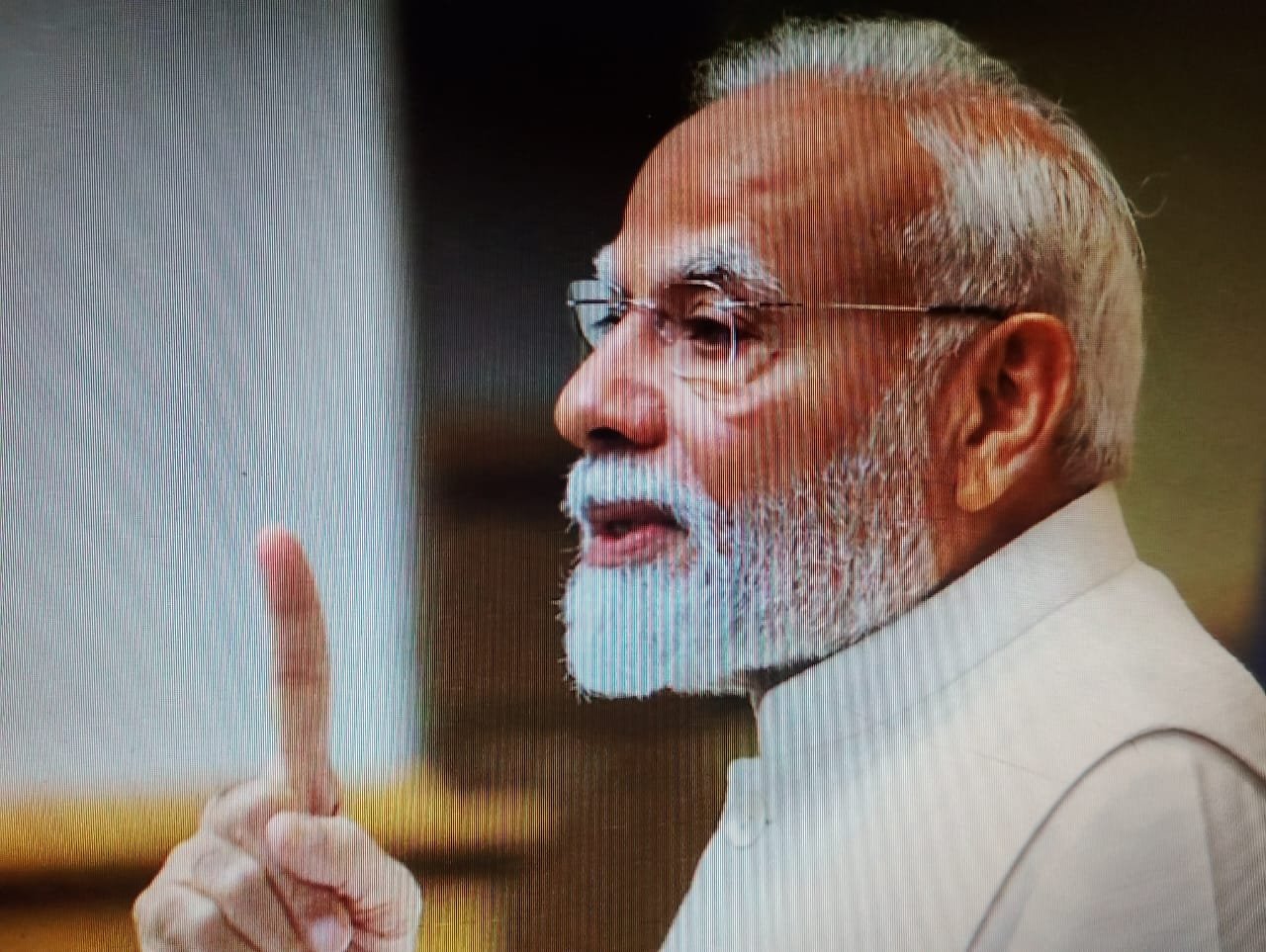
Contents
New Delhi, July 12, 2025
Saturday morning brought new hope for the youth of India as Prime Minister Narendra Modi, through video conferencing, virtually participated in employment fairs held across 47 cities and distributed over 51,000 appointment letters to newly selected candidates. These weren’t just ordinary documents—they symbolized the first step toward the dreams of thousands of young Indians, ready to build their own future.
“No Recommendations, No Bribes” — Jobs Now Based Solely on Merit
Addressing the event, Prime Minister Modi emphasized the government’s commitment to a transparent, fair, and efficient recruitment process.
“Today, jobs in India are no longer handed out through influence or favors, but through talent. This is the identity of the New India,” said PM Modi.
He further reiterated that young aspirants no longer need backing or bribes to secure government jobs. The government’s “No Recommendation, No Expense” initiative reflects this very principle.
Confidence Shines on Young Faces
One of the selected candidates from Jaipur, Rajasthan, Miss. Sharma, shared her experience with visible emotion:
“I never thought I’d get a government job without any connections or under-the-table payments. This government has made that possible. I can now see the dreams of my family shining in their eyes—and mine.”
Youth Power Will Build the Nation
The Prime Minister urged the newly recruited youth to treat their roles not just as jobs, but as opportunities for nation-building.
- “Wherever you are posted, your dedication and work ethic will shape the future of the country,” he said.
Art
Orange Day Adds a Splash of Joy at DAV Centenary Public School, Jaipur

Jaipur, July 10, 2025
The tiny tots of DAV Centenary Public School, Jaipur lit up the campus as they came dressed in cheerful shades of orange to celebrate Orange Day with great excitement and enthusiasm.
The pre-primary wing turned into a lively sea of orange—from clothes and accessories to creative decorations—all reflecting the spirit of joy, creativity, and energy that the colour symbolizes. Teachers thoughtfully planned the day to help children not just enjoy, but also learn the meaning behind the colour orange—a symbol of hope, enthusiasm, and prosperity.
The classrooms were buzzing with laughter and activity as the little learners took part in various fun-filled games, storytelling, drawing, and creative expression sessions. To boost their communication skills, each child was encouraged to bring an orange-coloured object from home and speak a few lines about it in front of their classmates. For many, it was their first public speaking moment, and they did it with adorable confidence.
Principal Mr. A.K. Sharma visited the classrooms to cheer on the children. He appreciated the thoughtful planning of the teachers and said, “Activities like these help children build confidence, express themselves freely, and connect learning with real-life experiences.”
It was a delightful sight to watch the little ones bursting with curiosity, dressed in glowing orange, exploring and expressing themselves. The day left behind not just smiles and laughter, but also a colourful memory in the hearts of the young students.
Education
Guru Purnima Celebration at DAV CPS, Jaipur – A Heartfelt Tribute to Guiding Lights
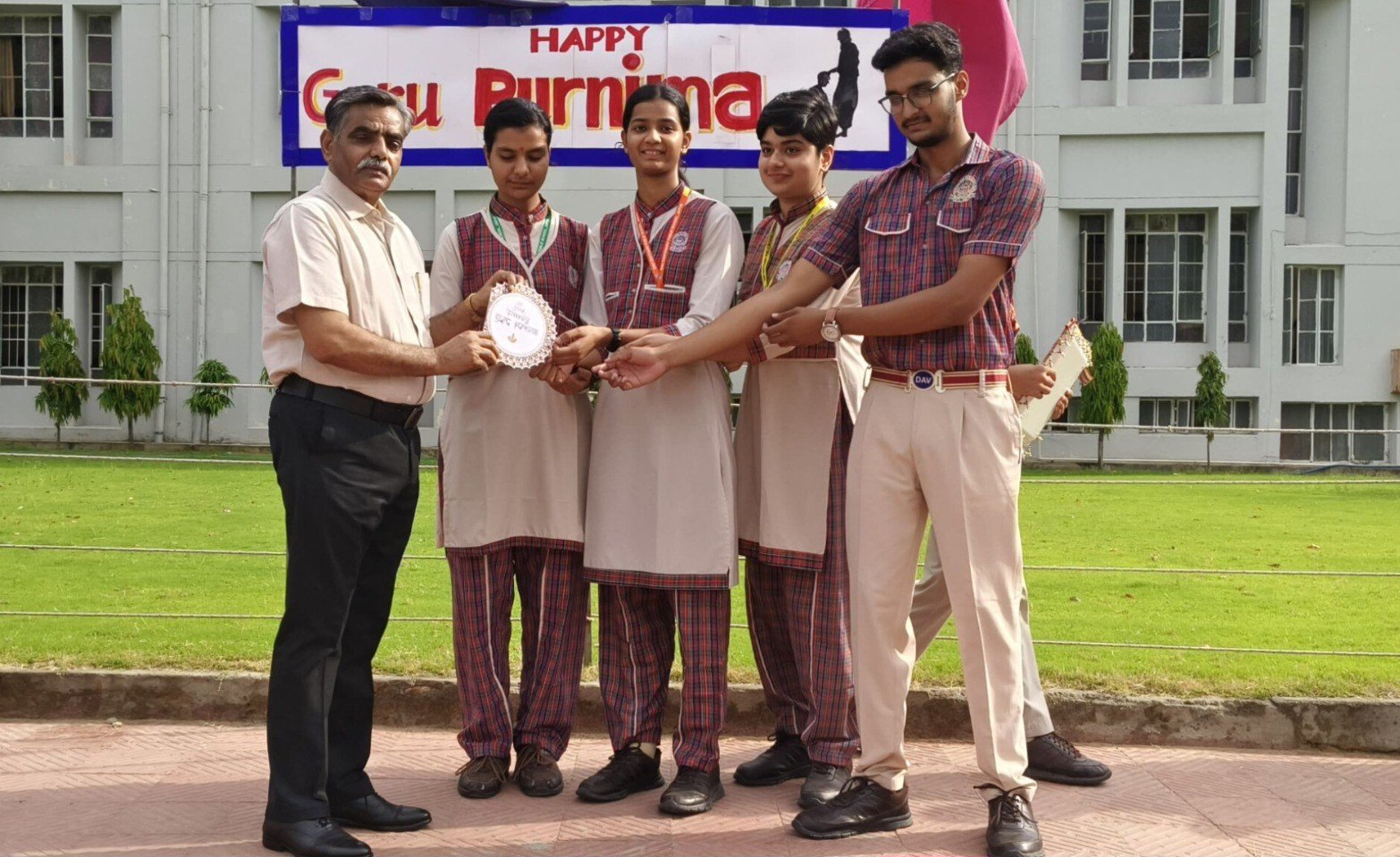
Jaipur | July 10, 2025
In an atmosphere filled with devotion, gratitude, and inspiration, DAV Centenary Public School, Vaishali Nagar, Jaipur celebrated Guru Purnima with heartfelt enthusiasm on Thursday, July 10. The event turned out to be more than just a celebration—it was a beautiful expression of love and respect for the teachers who illuminate the path of learning for their students.
The morning assembly set the tone for the day with the soothing sounds of shlokas dedicated to gurus, creating a spiritually charged environment across the campus. The essence of the celebration was beautifully captured in a speech that explained the cultural and historical roots of Guru Purnima, reminding everyone of the powerful legacy of the guru-shishya tradition.
Students poured their hearts out through soulful poems, melodious songs, and inspiring speeches, each echoing a shared sentiment—deep respect for their mentors. A mesmerizing classical dance performance, portraying devotion and reverence towards gurus, stole the spotlight and left the audience spellbound.
One of the most touching moments of the day was when the students presented a handmade gratitude card to Principal Mr. A.K. Sharma, who has been a constant source of wisdom and encouragement. In his address, Mr. Sharma reflected on the irreplaceable role of teachers in shaping young minds and urged students to stay rooted in values, discipline, and lifelong learning.
“The presence of a guru in one’s life is a blessing,” he said. “True success comes not just from knowledge, but from the humility to keep learning.”
The event concluded on a thoughtful note, leaving everyone—teachers, students, and staff—feeling more connected, more thankful, and more inspired. Guru Purnima at DAV CPS was not just an event, but an experience that reminded all of the timeless role of a teacher—not just in the classroom, but in life.
Crime
Indian Nurse to Be Hanged in 6 Days in Yemen — The Heartbreaking Story of Nimisha Priya, Who Gave Her Partner a Sedative That Turned Deadly

Contents
Thiruvananthapuram / Yemen | July11, 2025
Once a hopeful young nurse from Kerala, Nimisha Priya is now counting her final days in a Yemeni prison. Her crime — administering a sedative that led to the death of her Yemeni business partner, Alkhader Al-Omari. Her punishment — execution by hanging on July 13, 2025.
But behind this grim sentence lies a story much more complicated — one filled with ambition, control, fear, and a moment that changed everything.
A Nurse with Dreams, and a New Life Abroad
Nimisha Priya wasn’t a criminal when she left India. She was a caregiver — a skilled nurse with dreams of building a better life. In Yemen, she found work, opened a clinic, and partnered with Alkhader Al-Omari, a local man who helped her navigate the foreign land.
But what started as a partnership slowly turned into a prison.
Trapped in a Toxic Relationship
Reports from the time suggest that Al-Omari soon took control of more than just the clinic. He allegedly confiscated Nimisha’s passport, isolated her, and began mentally and physically abusing her. He took over her earnings and threatened her when she talked about returning home to India.
Far from family, friends, or legal protection, Nimisha felt completely trapped — her life and freedom in the hands of a man who, she believed, would never let her go.
The Night It All Changed
Then came that fateful night in 2017.
According to court documents, Nimisha gave Al-Omari a high dose of a sedative. Her stated intention was not to kill him, but to make him unconscious, retrieve her passport, and escape. But the sedative proved too strong — Al-Omari died.
Panic set in. Nimisha reportedly dismembered his body and tried to hide the evidence in a water tank. A gruesome and desperate act that, once discovered, left her no room to explain.
A Death Sentence, and a Race Against Time
The Yemeni court ruled the act pre-meditated murder and sentenced Nimisha to death by hanging.
For years, legal teams in India and Yemen pleaded for clemency. Activists pointed to the abuse she suffered, to the desperation of a woman with no escape, and to her otherwise clean record. Her mother, in tears, begged the Yemeni family for forgiveness, hoping for a “Diya” — blood money — a custom in Yemen that allows the victim’s family to pardon the accused.
But that pardon never came.
Only Six Days Left…
Today, Nimisha Priya is a prisoner not just behind bars, but in time. With just six days left, she awaits her execution. Her mother is still trying — hoping against hope — for one final miracle.
Meanwhile, millions in India are asking:
Was she a murderer? Or a victim of circumstance, trying to survive in a world where no one came to help?
Beyond the Verdict
This is not just Nimisha’s story. It’s the story of thousands of Indian women who work abroad, often with little protection. It’s the story of how desperation can drive someone to the edge, and how the law — especially in foreign lands — rarely leaves room for the grey in between.
Crime
India’s Biggest Scam You Never Heard Enough About — ₹49,000 Crore Vanished, 5 Crore Lives Shattered, And Now… One Big Arrest

Contents
Lucknow | July 11, 2025
In what could be one of the biggest financial frauds in India’s history, the curtain has finally started to lift. The Uttar Pradesh Economic Offences Wing (EOW) has arrested Gurnam Singh (69) — the key director behind Pearls Agrotech Corporation Ltd (PACL) — from Punjab’s Ropar district.
His crime? Allegedly orchestrating a ₹49,000 crore Ponzi scheme that duped nearly 5 crore investors across India.
This wasn’t just about money. It was about dreams sold and lives broken — mostly belonging to farmers, small shopkeepers, daily wage workers, and middle-class families who trusted PACL with their hard-earned savings.
The Dream That Turned Into a Trap
PACL promised affordable land investments. The plan sounded simple — invest now, and in a few years, you’d either get a valuable land parcel or high returns.
But behind the glittering promises lay a hollow scam.
No land. No returns. Just a web of false paperwork and delayed answers — until one day, even those stopped.
EOW’s New Face — Tough, Accountable, and On a Mission
What’s changed now? The UP EOW has introduced a “Reward and Punish” system to fast-track major financial crime probes like this:
- Monthly performance tracking of officers
- Fast-track teams deployed in every district
- Seizure of properties under Section 111 of the new BNS law
- Helplines, awareness drives, and social media alerts for public support
This new system has already led to 14 arrests, including key names linked to the ₹250 crore V-Care scam and this massive PACL fraud.
This Isn’t Just About Money — It’s About Betrayal
One woman investor said it best:
“We saved for our children’s education, for their future. Now we run around courts and collector offices, with nothing to show for it.”
Behind every number in this scam — there’s a family. A broken promise. A shattered future.
The Bigger Picture
This arrest proves one thing: Justice may be slow, but it’s not blind. ₹49,000 crore didn’t just disappear — it was siphoned off through trust and illusion. The real question now is:
Will India’s legal system bring back justice and money for 5 crore defrauded citizens? Or will this case too fade into the dust of files and forgotten hearings?
India
India Crosses 1.46 Billion — But Why Are People Having Fewer Children? UN Report Reveals the Changing Math of Population

Contents
New Delhi | July11, 2025
There was a time when India’s growing population was considered the country’s biggest problem. Slogans like “Hum Do, Hamare Do” (We Two, Our Two) echoed across walls and radio channels. But times have changed — and so has the narrative.
According to the latest report by the United Nations, India’s population has officially crossed 1.46 billion, making it the most populous nation on the planet. But what’s surprising is this: India’s fertility rate — the number of children a woman has — is steadily declining.
Today, the average Indian woman is giving birth to just two children, which is right around the replacement level needed to maintain a stable population.
So, if fewer children are being born, why is the population still rising? What’s really happening behind these numbers?
This Isn’t Just About Statistics — It’s a Social Shift
There was a time when India was labelled a “population bomb.” Now, several Indian states — including Kerala, Delhi, Tamil Nadu, Karnataka, and Punjab — have fertility rates below replacement level.
This isn’t happening due to force or law — but through education, awareness, and personal choice. It’s a quiet revolution led by society itself.
India is now slowly moving towards population stability, something once thought to be decades away.
Women Are Leading This Change
Behind these shifting numbers is a bigger story — the story of India’s changing women:
- They’re more educated
- They’re joining the workforce
- They’re marrying later
- And they’re making thoughtful, conscious decisions about motherhood
Children are no longer just a tradition — they’re a planned responsibility.
India’s Population Will Peak by 2060 — Then Begin to Decline
Experts say this population growth is the result of demographic momentum — a situation where the current large number of young people continues to reproduce, even as fertility falls.
But once this momentum slows, India’s population will gradually start to decline — marking the beginning of a new era.
That means: the country that is the youngest today may one day become one of the oldest nations in terms of age demographics.
The Real Question Now: What Will We Do With So Many People?
- Can we create enough jobs for all?
- Will our education and healthcare systems be able to handle the pressure?
- And when the population begins to shrink, who will take care of the elderly?
India now needs smart policies, not just to control numbers — but to improve the quality of its population. Because in the long run, it’s not just about how many people we have, but what those people can do.
The Population Game Has Changed
This UN report isn’t just another document filled with stats — it’s a signal that India is entering a new demographic era.
The country is slowly shifting its focus from “how many” to “how capable” — and that’s where real progress begins.
Crime
Shocking Crime in Gurugram: Rising Tennis Star Radhika Yadav Shot Dead — Father Pulls the Trigger Over Career Dispute

Contents
Gurugram | July 11, 2025
In a deeply disturbing incident that has sent shockwaves across Gurugram, 21-year-old national tennis player Radhika Yadav was shot dead in her own home on Sunday morning. The most heartbreaking detail? The shooter was none other than her own father.
Radhika, who had made a mark at the national level in the past two years and had recently been selected for an international tournament, was the pride of her neighborhood. But her promising journey was cut short not by a stranger, but by someone who was supposed to protect her — her father, Ravindra Yadav.
What led to the tragic shooting?
According to initial police reports, Ravindra Yadav confessed during interrogation that he shot Radhika “in a fit of rage.” Investigators reveal that Radhika was passionate about her tennis career and was preparing to travel abroad for further training and competitions — a plan that reportedly didn’t sit well with her father.
Sources close to the family say Ravindra had always been a strict and conservative man. He was uncomfortable with Radhika’s growing independence and career choices. Tensions had been simmering within the household for months. On Saturday night, a heated argument broke out, and by morning, the unthinkable had happened.
Community in shock
The neighborhood is still reeling from the tragedy. Neighbors describe Radhika as a humble, focused, and highly disciplined young woman.
“She would be out for practice every morning by 5 AM. That kind of dedication is rare these days,” said one neighbor, struggling to hold back tears.
Father arrested on the spot
Police arrested Ravindra Yadav at the scene. He has been charged with murder under relevant sections of the IPC. Radhika’s mother, who was reportedly present in the house during the incident, is in deep shock and under medical observation.
A nation reflects: Are dreams still a crime for daughters?
Radhika’s brutal murder has sparked widespread outrage and grief. It has reignited an uncomfortable question — are daughters still being punished for dreaming big?
When a father turns into the very obstacle his daughter must overcome, it’s a mirror held up to our society.
Latest News
Major Shift in Jaipur: Private and Roadways Buses to Operate Together from Heerapura Terminal – A Relief from City Traffic
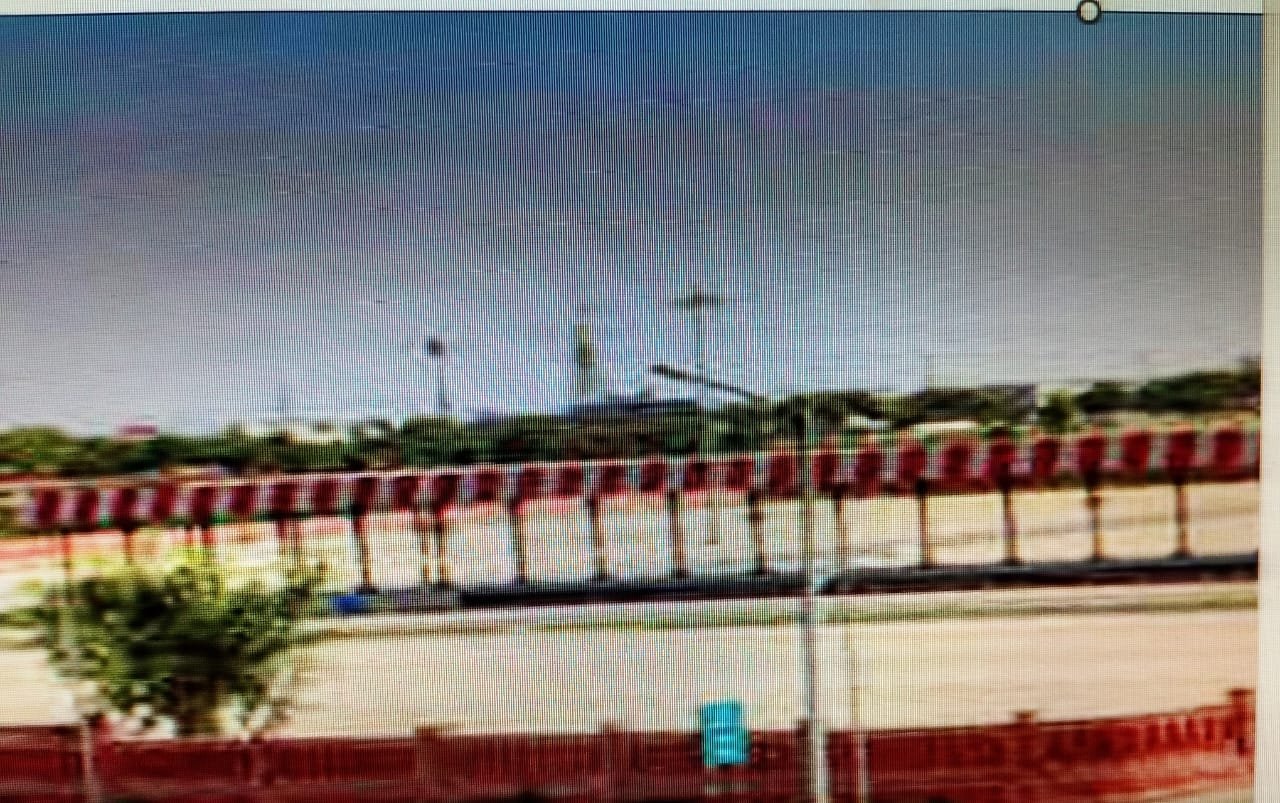
Contents
Jaipur | July 11, 2025
There’s good news for Jaipur residents—especially those tired of daily traffic jams. Starting August 1, 2025, both private and state-run (RSRTC) buses will operate together from the newly developed Heerapura Bus Terminal on Ajmer Road. This will be the first bus terminal in Rajasthan where both categories of buses run under the same roof, aiming to streamline urban transport and reduce traffic congestion.
Why is this change important?
Until now, private buses and RSRTC buses in Jaipur operated from different locations, causing severe congestion in areas like Sindhi Camp, Narayan Singh Circle, and stretches along Ajmer Road. With the Heerapura terminal becoming operational, these buses will now run from a single, organized location—helping ease traffic pressure in the city’s central zones.
What to expect at the new terminal?
The Heerapura terminal will feature:
- Ticket booking counters
- Trained staff for assistance
- Clean waiting areas and passenger seating
- Easy access through autos, minibuses, and local transport services
In its initial phase, the terminal will handle over 50 private buses and nearly 25% of RSRTC’s fleet, covering popular routes including Ajmer, Udaipur, Kota, Jodhpur, and Bikaner.
What do people say?
Locals and commuters have welcomed the move with optimism.
Rajesh Sharma, a resident of Ajmer Road, shared:
“We’ve been dealing with constant traffic jams for years. If this plan works, Jaipur will finally see smoother roads.”
Mohan Lal, a private bus operator, said:
“We did face some logistical issues in the beginning, but now the government seems well-prepared. This centralized system will bring more order to operations.”
Government gears up
The Transport Department, along with JCTSL and Rajasthan Roadways, is actively coordinating to ensure the terminal’s smooth launch. Bus schedules are being finalized, and the city’s local connectivity options—like autos and e-rickshaws—are being aligned to support easy access to the terminal.
In Summary
The Heerapura Bus Terminal is not just another infrastructure project—it’s a strategic move to make Jaipur’s traffic more manageable and travel more convenient. With both private and public buses operating from the same location, the city takes a significant step toward a cleaner, better-organized, and commuter-friendly transport system.
Latest News
Swiss Accounts, Conversion Racket, and Trapped Innocents — This Wasn’t a Saint, He Was a Predator
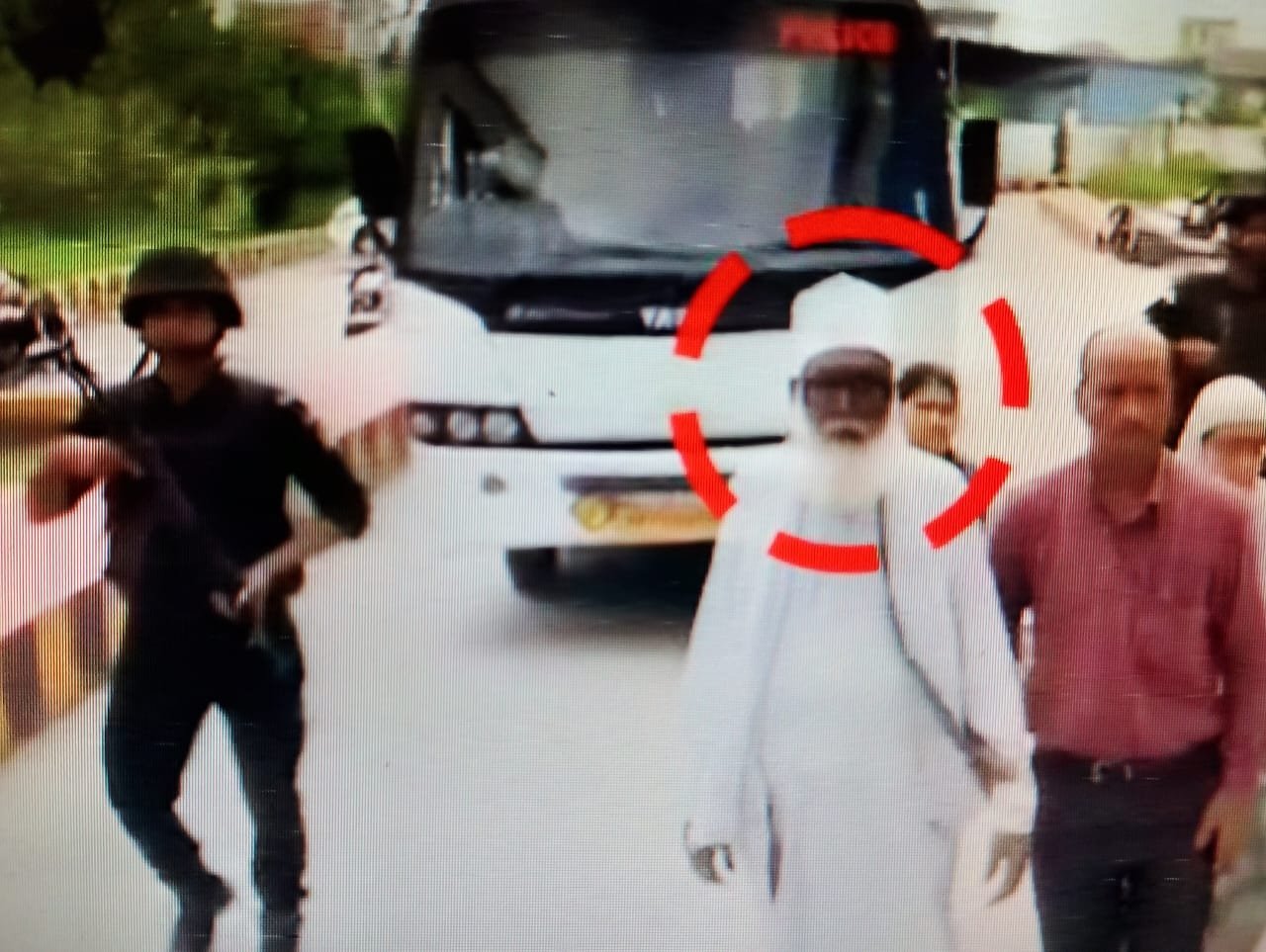
Contents
Uttar Pradesh | 11 July 2025
By Credent TV News Desk
He walked with a staff, wore a long beard, and people in the village folded their hands in reverence at his feet. But behind that saintly image was a man running one of the darkest religious conversion syndicates India has ever seen. His name: Changur Baba. Real name: Jalaluddin. Age: 70. And his list of crimes? Long enough to outlive his age.
A Full-Fledged Conversion Industry
Recent investigations by Uttar Pradesh STF and ATS have uncovered a deeply disturbing reality. This so-called baba wasn’t just chanting prayers — he was masterminding an elaborate system of trapping women and girls into forced religious conversions.
His targets? Minor girls, widows, and poor women — the most vulnerable in society.
His method? Manipulation, emotional blackmail, fake promises of marriage, and when that didn’t work — threats and money.
What’s even more shocking — Baba had a conversion training manual. A complete system of how to trap girls from different religions: what to say, when to act affectionate, and when to threaten.
Fixed rates were decided for each conversion. This wasn’t faith — it was business.
Crores in Swiss Bank Accounts
If you thought this racket was operating on a small scale, think again. Investigators discovered over 40 bank accounts linked to Changur Baba, including several in Switzerland. The total transactions? A staggering ₹106 crore (over $12 million).
Where did the money come from? Sharjah, Dubai, and other Islamic countries, according to the STF.
This was not just a religious racket — it was internationally funded and systematically operated.
Arrested — But the Net Is Wider
On 5th July, STF arrested Changur Baba along with his close aide, Neetu alias Nasreen, from a hotel in Lucknow. During interrogation, it was revealed that the network stretched far — from Mumbai to Dubai.
Now, the Enforcement Directorate (ED) has joined the investigation. A money laundering probe is underway, and authorities are preparing to seize assets and properties linked to the illegal trust and conversions.
A Saint No More
Changur Baba may be behind bars now, but the emotional scars he left on thousands of innocent women can’t be counted in case files or spreadsheets.
He exploited faith to deceive, used trust to destroy, and wore religion as a mask for crime.
As one STF officer said:
“He wasn’t a saint in White. He was a predator in disguise.”
The villagers who once bowed before him now raise questions. How did this go on for so long? And how many more like him are out there?
There’s an old saying:
“When fake saints rise, truth becomes the biggest casualty.”
But this time, the law has spoken. And Baba’s mask has finally fallen.
India
Bharat Bandh Today: Why Are 250 Million Workers on Strike? What’s Open, What’s Shut – Here’s Everything You Need to Know
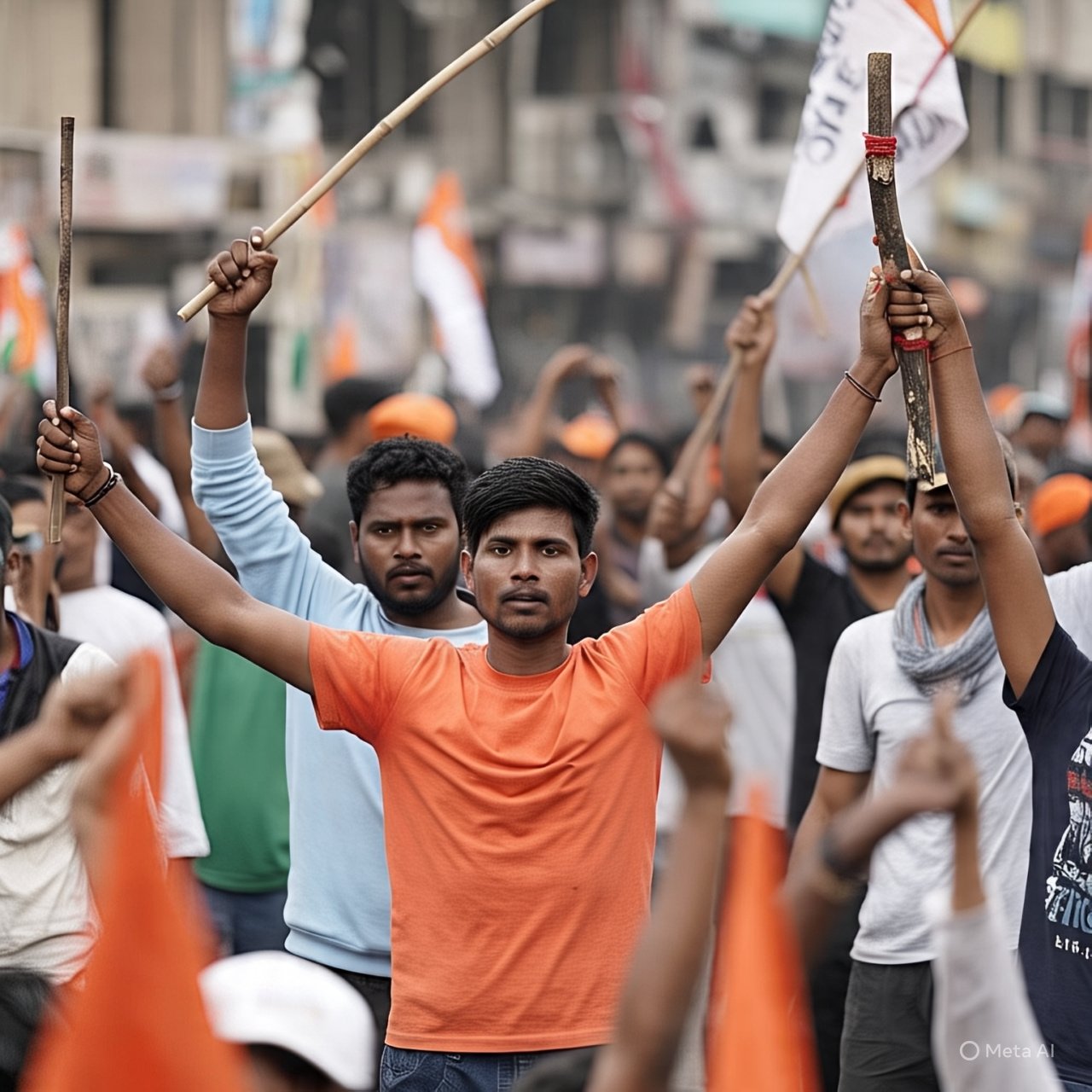
Contents
New Delhi | July 9, 2025
India woke up to a storm of slogans and silent streets today. With banners in hand and voices raised in unison, over 250 million workers and employees have joined a massive nationwide strike – the Bharat Bandh – protesting what they call anti-worker, anti-farmer, and pro-corporate policies of the central government.
This isn’t a symbolic protest. It’s being led by a powerful front of 10 central trade unions, supported by farmer organizations and rural labor unions. Together, they are sending one clear message – “Our voices matter.”
Why This Strike?
The protesting unions have raised serious allegations against the government:
- They say labor rights are being compromised.
- They accuse the government of aggressive privatization.
- They argue corporate interests are being prioritized over the common worker.
- They’re demanding protection of jobs, pensions, and public sector institutions.
Simply put, this bandh is not just about wages – it’s about respect, dignity, and survival.
Services Hit by the Strike
Several essential services across the country have felt the impact. Banking operations have slowed down due to staff participation in the strike. Postal services in many regions are suspended. In some states, public transport has been disrupted, leading to traffic snarls. Industries like coal, steel, and construction are reporting work stoppages. Even the power sector may experience temporary outages due to absentee staff.
What Remains Open?
Despite the unrest, hospitals and emergency services continue to function normally. Most schools, colleges, and private offices are open. Railways are largely operational, though some delays have been reported due to protests in certain regions. Markets and shops are also open in most cities, as trade unions and retail bodies have not actively joined the bandh.
Where the Impact Is Strongest
States like Kerala, West Bengal, Tamil Nadu, and Jharkhand have seen major protests, rallies, and transport blockades. In Gujarat, Maharashtra, and Punjab, the effect is more limited but still visible in sectors like banking and heavy industry.
Voices from the Ground
“We are not asking for favors. We are demanding what is rightfully ours – fair wages, job security, and dignity,” said a worker protesting in Ranchi.
“This bandh is a message to the government – listen before it’s too late,” said a union leader from Kolkata.
What Should You Do Today?
If you need to visit a government office, bank, or post office – call ahead to confirm. If you’re commuting, keep track of traffic and avoid areas with active protests. Stock up on essentials if you’re in a region where services are being disrupted.
The Bottom Line
Bharat Bandh 2025 is more than a strike – it’s a reminder that the people who build this nation also have the power to stop it when ignored. The coming days will reveal whether this united voice of workers leads to policy change, but for today, one thing is certain – the streets have spoken.

 Education1 month ago
Education1 month agoKota ICICI Bank Staffer Swindles ₹4.5 Crore, Gambles It All on Stock Market

 Education2 weeks ago
Education2 weeks ago11 Powerful Reasons Why DAV International Yoga Day Jaipur Uplifted Spirits!

 Bollywood1 month ago
Bollywood1 month agoHousefull 5 Movie Review: Akshay Kumar, Riteish Deshmukh Bring Laughter and Twists in Bollywood’s Biggest Comedy Franchise

 Cricket1 month ago
Cricket1 month agoBengaluru Chinnaswamy Stadium Stampede: 11 Dead, 33 Injured in RCB Victory Parade Chaos

 Education2 weeks ago
Education2 weeks ago7 Inspiring Highlights of DAV Foundation Day Jaipur Celebration – Amazing Vedic Legacy Revealed!

 Education2 weeks ago
Education2 weeks agoEmpowering Educators: A Three-Day Learning Journey at DAV Centenary Public School, Jaipur

 Credent TV2 weeks ago
Credent TV2 weeks agoVIBGYOR Summer Camp Ends on a High at DAV Centenary Public School, Jaipur

 Election4 days ago
Election4 days agoDAV Centenary Public School, Vaishali Nagar, Jaipur Event Report: Talent Hunt Show


































